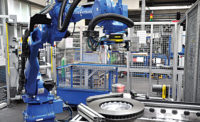Assembly in Action: Auto Manufacturer Uses Vision to Error-Proof Panels
For automotive manufacturers, customer satisfaction is the key to increased sales and long-term growth. Among the hundreds of subassemblies that go into each automobile or truck, the quality of the body panels plays an important role in getting and keeping a satisfied customer. Specifically, closure panels, such as doors, hoods, lift gates and tailgates, must be correctly manufactured to meet crash safety requirements. Equally important is the need to keep dirt, water and road salts out to prevent premature rust and corrosion.
In addition to customer satisfaction, the direct costs of containment, scrap, rework, safety recalls and rust-through warranty expenses provide compelling reasons for error-proofing body panels through 100 percent inspection using automated machine vision inspection. This is why DaimlerChrysler's Warren Stamping Plant (Warren, MI) has dozens of machine vision systems with plans to employ more in the future.
Production of closure panels at the facility is a highly automated process, and automated processes demand automated inspection. The closure panel assembly process involves mating the inner and outer panels together. Inspecting hem adhesive, antiflutter beads, structural reinforcements, sound deadener patches, hole dimensions, weld studs and glass channels just before the two panels are permanently joined is a crucial requirement.
After being stamped out in the pressroom and delivered to the assembly line, the outer closure panel is placed in a nest, where the hem adhesive can be applied. A robot applies a 3-millimeter-wide bead of adhesive to the outside edge of the outer body panel, just inside a flange that will be hemmed on the edge of the inner panel. The hemming process spreads the hem adhesive to form the hem seal. Marrying the two panels with the hem seal gives rigidity and strength to the finished panel, and seals out moisture and dirt to prevent leaks and rust. During this process, gaps in or misplacement of the adhesive bead can occur due to the robot nozzle being out of position or a panel moving in the nest. A small gap near the top of the door panel is acceptable. There can be no gaps in the bead at the bottom due to corrosion and rust-through concerns.
When the robot returns to its home position, the line programmable logic controller (PLC) triggers a Passport DSL vision system from PPT Vision Inc. (Eden Prairie, MN), which snaps images of the panel using multiple cameras and specialized LED strobe lighting. Up to 12 DSL digital cameras are used, depending on the type of panel being inspected. PPT Vision designed the lighting for this application. The lighting is immune to ambient light, excessive oil or other changes in panel reflectivity. Each image is processed to inspect for adhesive bead presence, location and gaps. Antiflutter beads, sound deadener patches, structural patches, weld studs and glass channels can be inspected at the same time or at another station. Additionally, the vision system can determine the presence, location and size of window, door handle and other openings.
The PLC waits for a pass or fail response from the vision system, which takes less than a half second. If the panel passes, it's moved to the next assembly station. A new panel is then placed in the nest, and the process repeats itself. If the bead evaluation system finds a problem, it alerts the operator and locks the image of the failed area on its control panel. The system sends a signal to the line PLC. The line stops automatically and will not allow the panel to move to the next station. The operator confirms the failure and hits a reject switch that automatically removes the panel from the nest to the reject bin. At this point, a nonconforming panel costs about $125 to scrap. If left uninspected, the same panel could cost many hundreds of dollars to replace when it fails in the field, not including the cost of labor, warranty administration and damaged customer relations.
Before implementing the Passport DSL system, operators would pull a panel off the line for a manual inspection. This was done on a schedule that varied from once an hour to once a shift. A destructive test, where the inner and outer panels are cut apart for inspection, is still performed once per shift to check for adhesive wet-out. At production speeds of up to 240 panels per hour, this sampling technique led to many faulty panels making it through to final assembly. "The cost savings have been enormous. One catch usually gives us our return on investment," says Dale Frendburg, adhesive specialist at the Warren Stamping Plant.
At first operators resisted using the vision systems. But with improvements in the system's robustness and ease-of-use, the operators now realize the system's value in helping them be more efficient, producing only high-quality panels.
The vision system is set up to automatically save failed images and other data at regular intervals for analysis and process improvement. This helps to prevent recurring faults.
For more information on machine vision, call 952-996-9500 or visit www.pptvision.com.
Looking for a reprint of this article?
From high-res PDFs to custom plaques, order your copy today!



